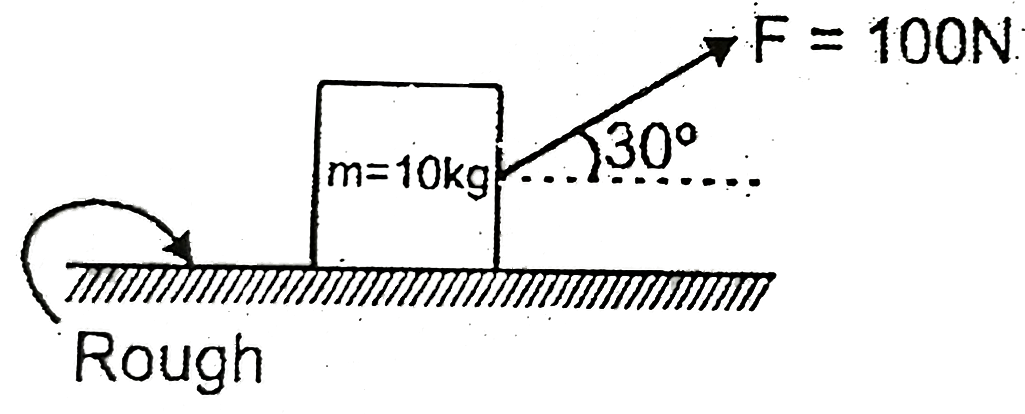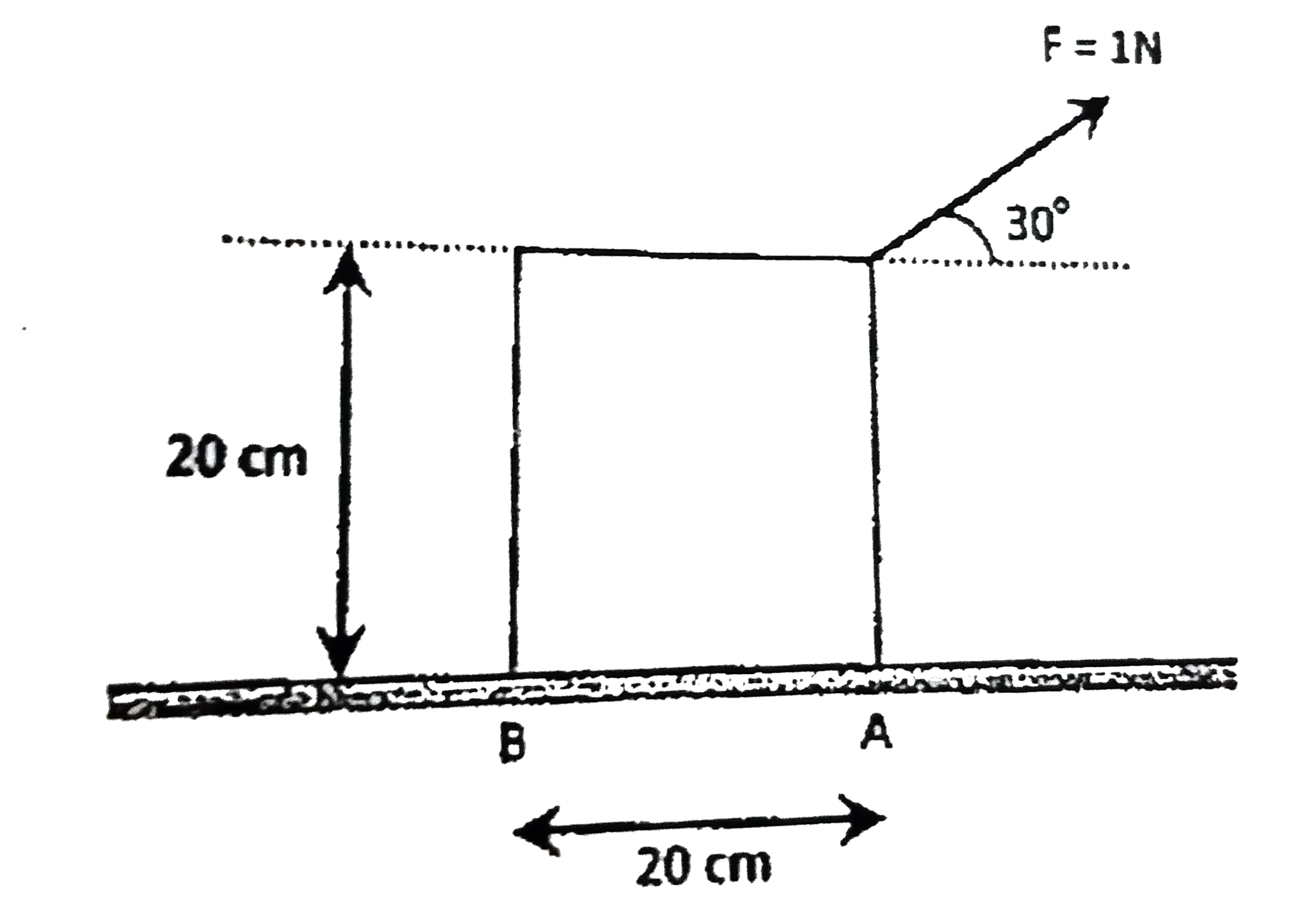A block of weight 9.8N is placed on a table. The table surface exerts an upward force of 10 N on the block. Assume g=9.8m/s2.
The block exerts a force of 10N on the table
The block exerts a force of 19.8 N on the table
The block exerts a force of 9.8N on the table
The block has an upward acceleration
The correct Answer is:A, D
To solve the problem, we need to analyze the forces acting on the block placed on the table. Here’s a step-by-step breakdown:
Step 1: Identify the Forces
The block has two main forces acting on it:
1. Weight (W): This is the downward force due to gravity, which is given as 9.8 N.
2. Normal Force (N): This is the upward force exerted by the table on the block, which is given as 10 N.
Step 2: Draw a Free Body Diagram
We can visualize the forces acting on the block:
- Draw a downward arrow representing the weight (9.8 N).
- Draw an upward arrow representing the normal force (10 N).
Step 3: Apply Newton's Second Law
According to Newton's second law, the net force acting on the block can be calculated as:
Fnet=N−W
Where:
- N=10N (upward force)
- W=9.8N (downward force)
Step 4: Calculate the Net Force
Substituting the values into the equation:
Fnet=10N−9.8N=0.2N
Step 5: Determine the Mass of the Block
Using the weight of the block to find its mass:
W=mg
Where:
- W=9.8N
- g=9.8m/s2
Rearranging gives:
m=Wg=9.8N9.8m/s2=1kg
Step 6: Calculate the Acceleration
Now, we can find the acceleration of the block using the net force and mass:
Fnet=ma
Rearranging gives:
a=Fnetm=0.2N1kg=0.2m/s2
Final Result
The acceleration of the block is 0.2m/s2.
---
The block has two main forces acting on it:
1. Weight (W): This is the downward force due to gravity, which is given as 9.8 N.
2. Normal Force (N): This is the upward force exerted by the table on the block, which is given as 10 N.
We can visualize the forces acting on the block:
- Draw a downward arrow representing the weight (9.8 N).
- Draw an upward arrow representing the normal force (10 N).
According to Newton's second law, the net force acting on the block can be calculated as:
Fnet=N−W
Where:
- N=10N (upward force)
- W=9.8N (downward force)
Substituting the values into the equation:
Fnet=10N−9.8N=0.2N
Using the weight of the block to find its mass:
W=mg
Where:
- W=9.8N
- g=9.8m/s2
m=Wg=9.8N9.8m/s2=1kg
Now, we can find the acceleration of the block using the net force and mass:
Fnet=ma
Rearranging gives:
a=Fnetm=0.2N1kg=0.2m/s2
The acceleration of the block is 0.2m/s2.
Topper's Solved these Questions
- BOOK - D MUKHERJEECHAPTER - KINEMATICS, FORCESEXERCISE - Type 222videos
KINEMATICS, FORCES
- BOOK - D MUKHERJEECHAPTER - KINEMATICS, FORCESEXERCISE - Revision Exercise26videos
KINEMATICS, FORCES
- BOOK - D MUKHERJEECHAPTER - IIT QUESTIONS 5EXERCISE - Matrix matching type2videos
IIT QUESTIONS 5
- BOOK - D MUKHERJEECHAPTER - MISCELLANEOUS QUESTION 1EXERCISE - Miscellaneous Questions-1 (Straight-Objective Type)54videos
MISCELLANEOUS QUESTION 1
Similar Questions
A block of weight 5 units is placed on a horizontal table. A person pushes the block from top by exerting a downward force of 3 units on it. Find the force exerted by the table on the block.
View SolutionA block with a weight of 4.0 N is at rest on a horizontal surface A 1.0 N upward force is applied to the block by means of an attached vertical string. What are the (a) magnitude and (b) direction of the force of the block on the horizontal surface ?
View Solution
Knowledge Check
- Question 1 - Select One or More
A block of weight 9.8N is placed on a table. The table surface exerts an upward force of 10N on the block. Assume g=9.8m/s2.
AThe block exerts a force of 10N on the tableBThe block exerts a force of 19.8N on the tableCThe block exerts a force of 9.8N on the tableDThe block has an upward acceleration. - Question 2 - Select One or More
A block of weight 9.8N is placed on a table. The table surface exerts an upward force of 10N on the block. Assume g=9.8m/s2.
AThe block exerts a force of 10N on the tableBThe block exerts a force of 19.8N on the tableCThe block exerts a force of 9.8N on the tableDThe block has an upward acceleration. - Question 3 - Select One
A block is placed on a horizontal table. Identify the force of action
Aweight of blockBsupport of table on the blockCeither (a) or (b)Dneither (a) nor (b).
A block of weight 20 N is placed on a horizontal table and a tension T is applied on the block . Tension can be increased to 8 N before the block begins to slide . A force of 4 N keeps the block moving at constant speed , once it has been set in motion . Find the coefficients of static friction and kinetic friction].
View SolutionA block of mass 10kg is placed on a horizontal surface as shown in the figure and a force F=100N is applied on the block as shown, in the figure. The block is at rest with respect to ground. If the contact force between block and ground is 25n (in Newton) then value of n is : (Takeg=10m/s2)
 View Solution
View SolutionA block of mass 10 kg is sliding on a surface inclined at 30∘ with horizontal . If coefficient of friction between the block and the surface is 0.5 , find acceleration produced in the block . Take g=9.8m/2 .
View SolutionThe sides of rectangular plate of mass 20 kg is 5 m x 4 m placed on a horizontal table. The pressure exerted by the block on the table is (Take g=10ms2)
View SolutionA block of mass √3/10kg is placed on a rough horizontal surface as shown in the figure. A force of 1N is applied at one end of the block and the block remains stationary. The normal force exerted by the sruface on the block acts(g=10m/s2)
 View Solution
View Solution

